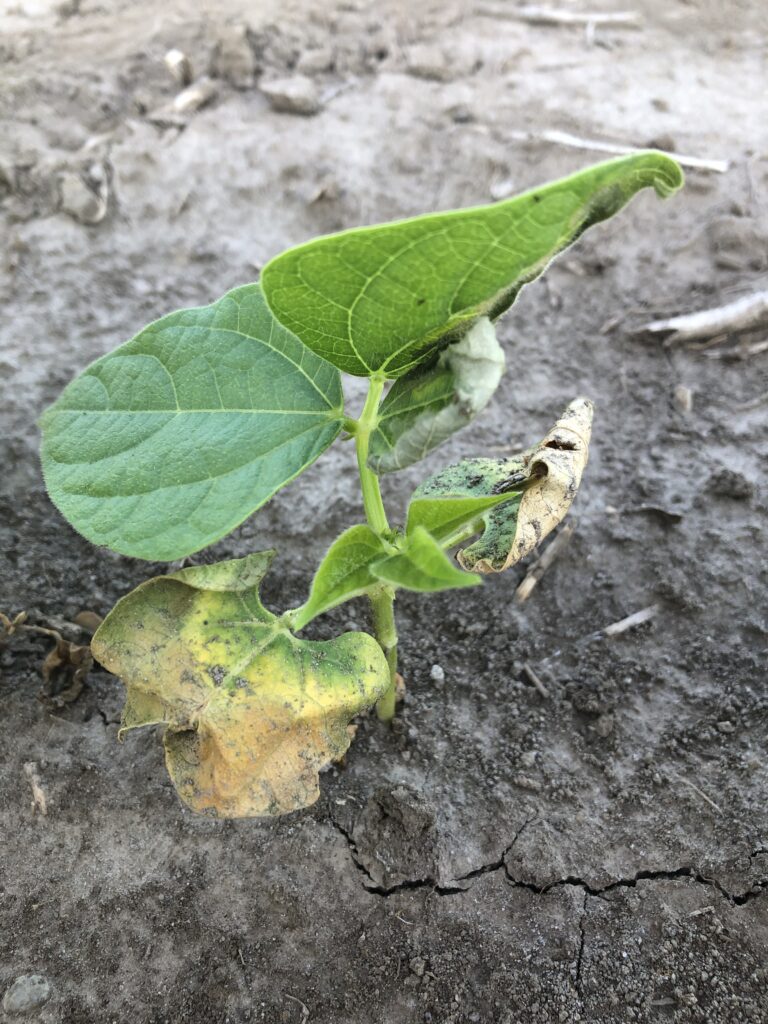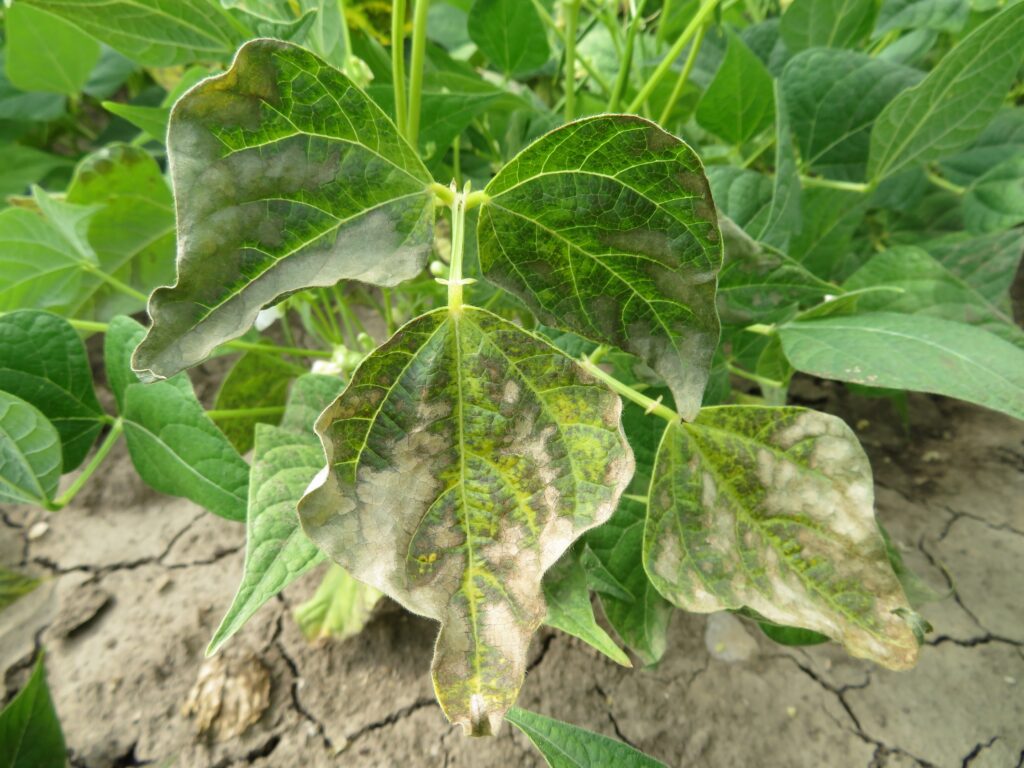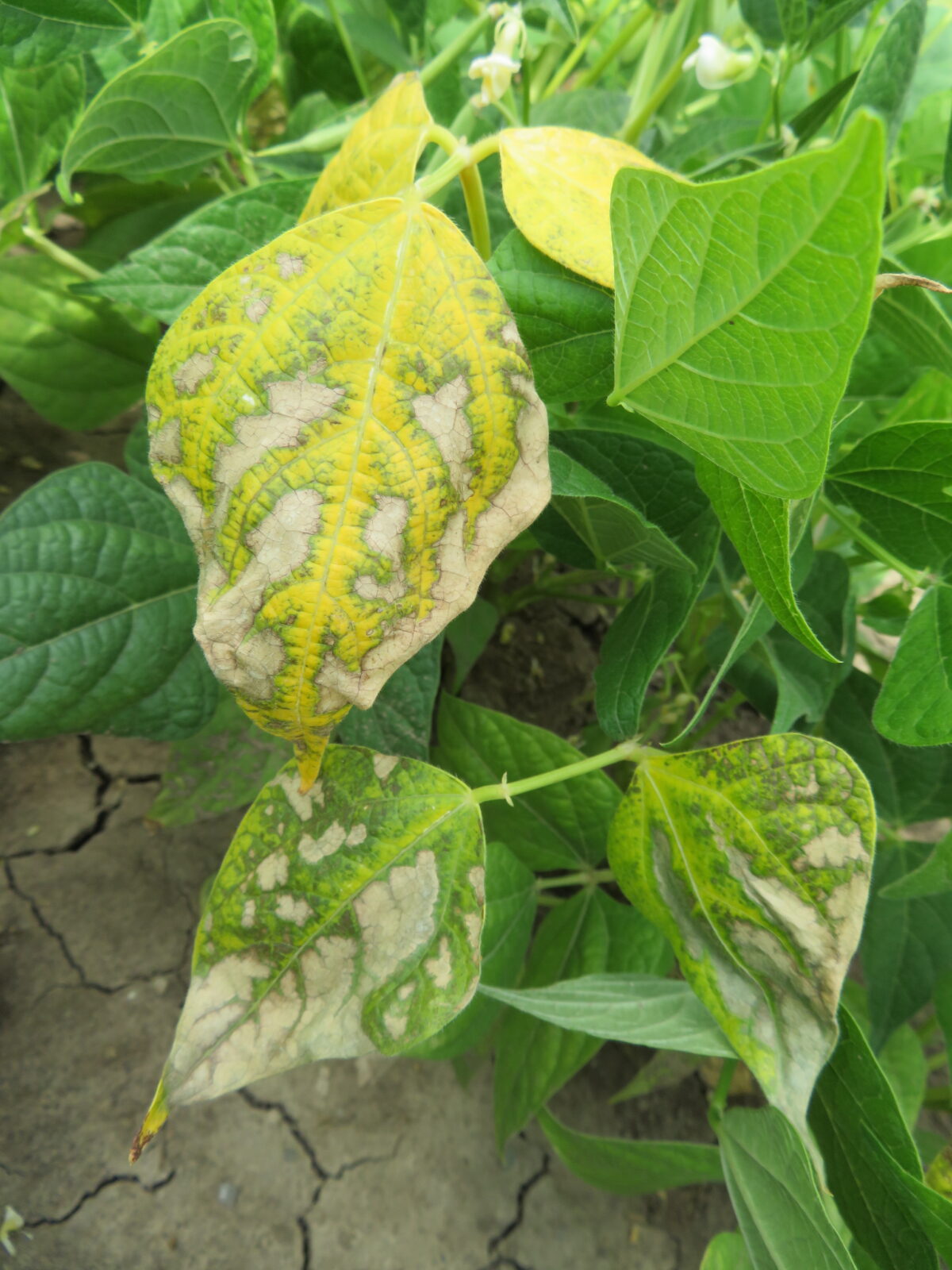Bacterial wilt is caused by the pathogen Curtobacterium flaccumfaciens pv. flaccumfaciens.
Symptoms
Interveinal chlorosis on leaflets leading to necrotic areas surrounded by yellow. Necrotic tissue may tear, giving ragged appearance. Necrotic tissue may fall away causing defoliation, or leaves may drop off in windy conditions. Plants will wilt and may look brown coloured from a distance. Seed (particularly white coloured seed) will be discoloured and become yellow, orange, pink or purple.
Symptoms are similar to common bacterial blight (CBB) but occur between leaf veins and are often accompanied by plant wilting and death. Water soaked lesions are less likely to be observed on pods with bacterial wilt.
Infection of young seedlings is typically from infected seed, and symptoms are often visible at the cotyledon stage and/or second trifoliate. Early infection is likely to result in plant death. Plants that survive remain stunted with severe yellowing and wilting and are unlikely to produce seed. Infection of older plants results in slower and less severe disease development, and is less likely to result in discoloured, infected seed. Note that if infected plants produce infected seed, the exterior of the pods may look normal. Economic yield loss has been documented Canada and the central High Plains of the USA.
Disease Cycle
Contaminated seed is considered the main method of introduction. Infection can also occur or spread through wounds in plant tissue. Plant to plant transmission within a field is caused with high levels of leaf moisture and enhanced by wind-driven rain, hail or other causes of physical damage such as scouting, cultivating, and sprayers moving through the field. It is not as easily spread through rain or movement of equipment as is CBB. The bacteria can survive on unburied plant residue.
The bacteria are present in plant vascular tissue and interfere with normal water movement from roots to foliage. Bacterial wilt is most common in areas with hot summers (over 30°C), high precipitation and humid conditions. Environmental stresses, such as hot daytime temperatures and moisture stress, increase disease severity and can lead to sudden death of infected seedlings. Halo blight is more common in cooler, moister conditions compared to the hotter, drier conditions that are conducive to bacterial wilt.
Common bean (Phaseolus vulgaris) is the primary and most susceptible host. The host range includes adzuki bean (Vigna angularis), soybean, lima bean, mung bean, pea, scarlet runner bean, yardlong bean and other bean types not common in Ontario. In soybean, the disease is called tan spot. Tan spot in soybean usually results in less severe wilting and less defoliation, with necrotic tissue appearing more tan than brown. Transmission of the bacteria through the plant to seed is less likely to occur with later onset of infection, and less likely in soybean.
Management
Purchase certified, disease free seed. Note that testing seed lots can be difficult because one or two infected seeds in a bag can result in symptoms in the field. Incorporate infected bean residue into the soil after harvest. Rotate away from susceptible crops for 2 years and control volunteer bean plants. Minimize in-crop cultivation damage to roots.
Resistant varieties could be grown but bacterial wilt is not a major focus of local breeding programs and susceptibility ratings of locally adapted varieties are not available. One study has shown the dark red kidney varieties Cabernet and Red Hawk, and light red kidney varieties Redkanner and Chinook express resistance to bacterial wilt. Streptomycin, an antibiotic, is no longer registered for use as a seed treatment in Canada. Several studies have shown that copper-based chemicals are ineffective on bacterial wilt. Fungicides will not provide protection against bacterial diseases.
References
Osdaghi, E., Young, A.J. and Harveson, R.M. (2020). Bacterial wilt of dry beans caused by Curtobacterium flaccumfaciens pv. flaccumfaciens: A new threat from an old enemy. Molecular Plant Pathology, 21, 605-621. https://bsppjournals.onlinelibrary.wiley.com/doi/full/10.1111/mpp.12926
Recognition and Management of Dry Bean Production Problems (1983). North Central Regional Extension Publication 198.


